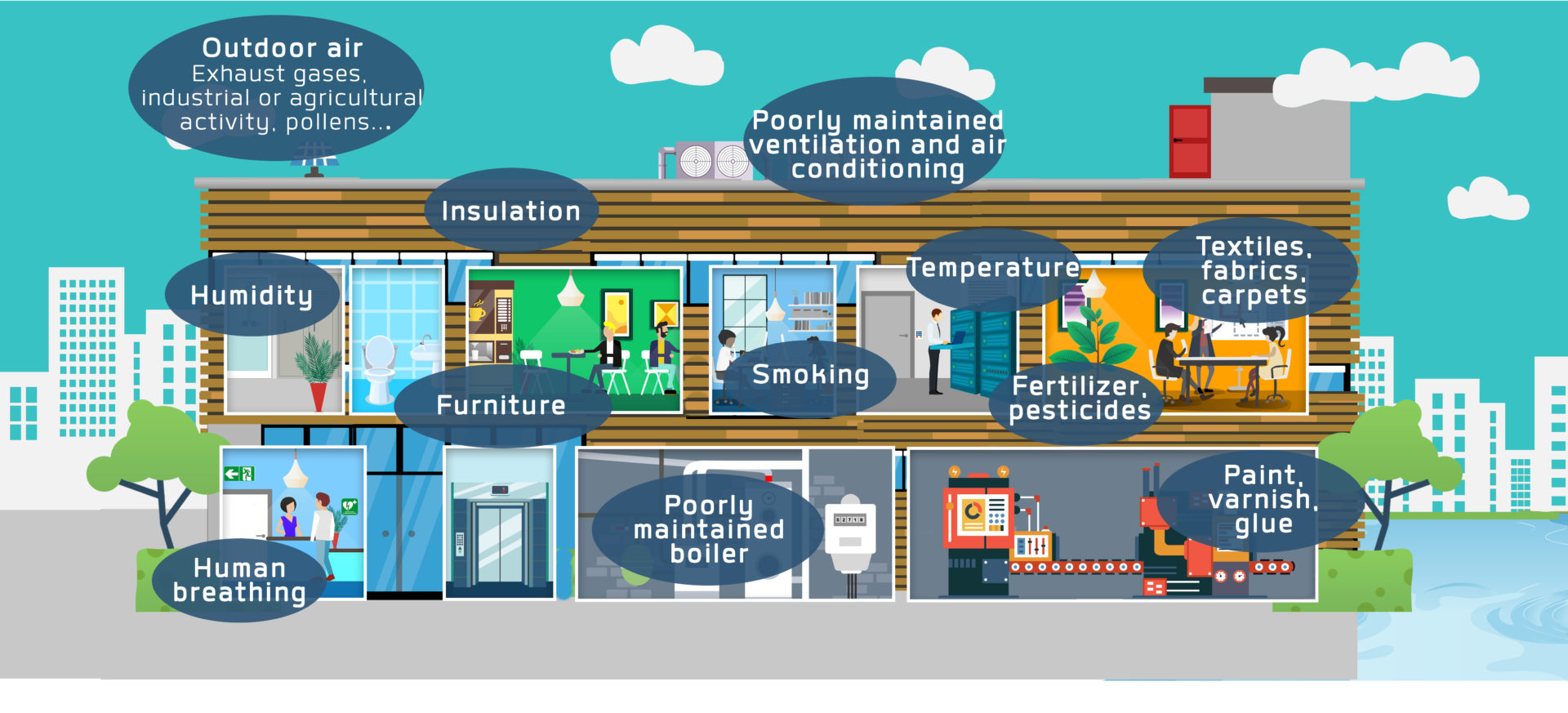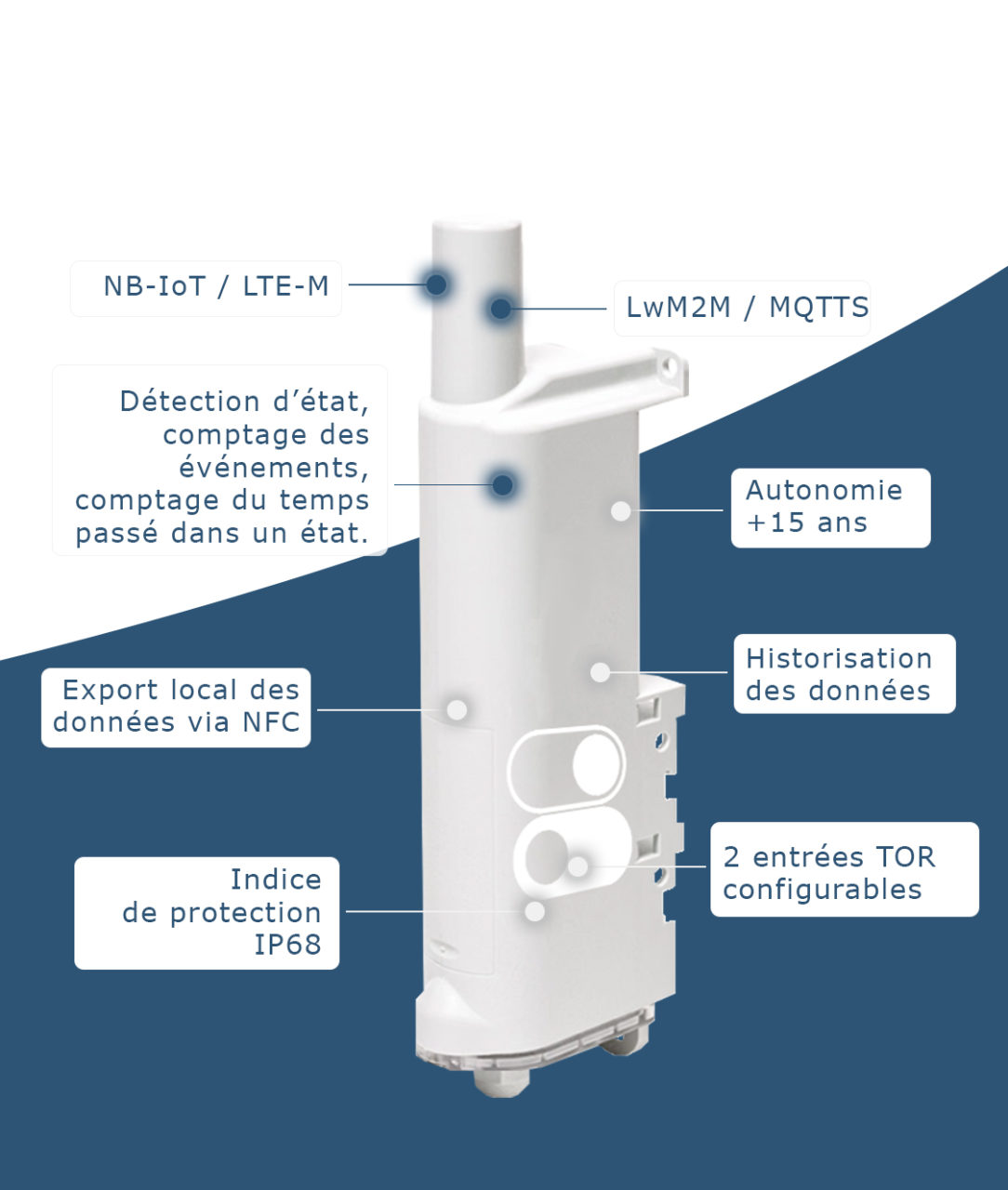Driven by the health crisis, the need for Indoor Air Quality analysis has increased tremendously in the past few months.
However, preventing the spread of COVID19 is not the only reason why building managers and owners are interested in this subject.
Whether it is to meet legal obligations, health issues, or economic issues, all buildings are now subject to the analysis of Indoor Air Quality (IAQ).
In this article, we offer a focus on the main aspects of indoor air quality and on the actions needed to be taken to improve it.
KEY FIGURES on indoor air quality
The estimated cost per year in France of poor indoor air quality
0 Md€
The number of deaths per year due to indoor air pollution (ANSES)
0 m
The average time an adult spends in enclosed spaces
0 %
indoor air quality regulations
ERP
In 2013, the Ministries of Environment and Health launched an Action Plan on Indoor Air Quality. The subsequent law made it mandatory to monitor air quality in certain establishments receiving a sensitive public:
January 1st
2018
Establishments welcoming children under 6 years old
Daycare centers, preschools
January 1st
2020
Elementary schools
January 1st
2023
Other ERP welcoming children and sensitive establishments
Middle schools, high schools, leisure centers, educational or vocational training institutions
January 1st
2020
Other priority ERP
Hospitals, nursing homes, medical-social establishments, social accommodation structures
A 2-step process:
- an assessment of the ventilation system (e.g.: presence of a VMC in the sanitary facilities). This evaluation can be carried out by the technical services of the establishment,
- the implementation of either:
- a pollutant measurement campaign by an accredited organization. These pollutants can be CO2, formaldehydes (present in agglomerated wood), benzene or even perchloroethylene. If the limit values are exceeded, action must be taken to comply with the safety thresholds.
- a self-assessment of the air quality with the help of the practical guide, allowing to establish an action plan. The purpose of this practical guide is to provide operational assistance to the various categories of stakeholders in childcare facilities (management team, people in charge of the activities in the occupied room, technical services and maintenance staff) in order to initiate a proactive and coordinated approach to improving indoor air quality. Its use is intended to quickly identify actions which will improve indoor air quality. As part of the implementation of this guide, facilities may use sensors to monitor air quality.
offices
“In closed rooms with non-specific pollution, where employees are required to stay, the air is renewed in such a way as to maintain a state of purity of the atmosphere capable of preserving the health of the workers, avoiding exaggerated temperature rises, unpleasant odors and condensation.”
A minimum incoming flow of fresh air per occupant must be respected (article R. 4222-6).
- 25 m3 per hour for offices and premises without physical work.
- 30 m3 per hour for restaurants, openspaces and meeting rooms.
- 45 m3 per hour for workshops and premises with light physical work.
- 60 m3 per hour for other workshops or premises.
The consequences of poor air quality
EFFECTS ON HEALTH AND WELLNESS
Depending on the duration and intensity of exposure, poor air quality will have more or less harmful effects on health.
In the most serious cases, a distinction is made between:
- effects linked to brief exposure to pollutants at high concentrations, which will lead to skin and/or respiratory tract irritation, nausea, headaches and even death in the case of carbon monoxide poisoning,
- effects linked to long-term exposure to low doses, which cause: serious respiratory, neurological or cardiovascular pathologies, or even the development of cancer.

However, in the most of the cases, exposure to unhealthy air may cause:
- headaches,
- fatigue,
- irritation of the respiratory tract,
- allergies…
Although some of these symptoms may be relatively benign, they have a real and significant impact on the quality of life inside the building. Air that is too hot, too dry, too polluted… will create a real feeling of unease among the people present in the building.
IMPACTS ON PRODUCTIVITY
More and more studies also show that poor air quality will have a lasting effect on concentration.
Employees or schoolchildren who work in unhealthy air are more likely to lose attention and thus to lose productivity or learning capacity. They will also be absent from work more often because they feel unwell. Studies have shown that working in unhealthy air can lead to a productivity drop of up to 15%.
A recent European study on 800 pupils in 8 schools also linked it to reduced concentration and performance at school¹.
¹Myhrvold, A.N., E.Olsen, et al., Environnement intérieur des écoles – Santé et performance des élèves au regard des concentrations en CO2
EFFECTS ON THE BUILDING
Monitoring air, temperature and humidity will also have consequences for the life on the building. Too much humidity in a building will lead to the development of mould and will therefore damage the building. Ensuring good air quality therefore helps to maintain the value of the building.
what to look for

Carbon dioxide (CO2)
Pollutant from human breathing. Can generate a feeling of confinement (need to open windows).
Volatile Organic Compounds (VOCs)
Gases and pollutants released by furniture and building materials in the building. Can cause discomfort.
Fine particles (PM1, PM2.5, PM10)
Dusts mainly from outside. Can be inhaled through the respiratory tract.
Thermal comfort (temperature and humidity)
Air that is too dry promotes the volatility of particles and dries out mucous membranes and eyes. Air that is too humid favours the development of moulds and dust mites.
In general, monitoring outdoor air quality forecasts is also recommended to adapt ventilation and aeration periods.
SOLUTIONS FOR MEASURING INDOOR AIR QUALITY
In order to assess indoor air quality (IAQ), the first thing to do is to implement solutions to measure the concentration level of the different pollutants and components presented above.
It is therefore necessary to set up sensors to monitor:
- Co2 levels,
- the level of VOCs,
- the level of fine particles (PM1, PM2.5 and PM10),
- temperature,
- humidity,
- the operation of ventilation systems.
Once the data has been collected, the important thing is to know how to read it. For this purpose, there are indicators, such as ICONE and TAIL, which combine the data collected by these sensors and give a clear and understandable indication of the air quality level.
ICONE Index
Daily room containment level (CO2).
TAIL indicator
User comfort (temperature, humidity, CO2, PM2.5 and light levels).
Operation indicator
Anticipate maintenance or increase reactivity in case of breakdown.
Fouling indicator
Anticipate filter maintenance.
ACTIONS TO IMPROVE INDOOR AIR QUALITY

Ensure that ventilation systems are working properly

Ventilate regularly

Controlling indoor temperature and humidity
IDENTIFY & ACT
- Do not smoke indoors, even with windows open.
- Have combustion appliances checked by a professional every year before the beginning of winter.
- Avoid using mobile fuel-burning space heaters and generators indoors.
- Act on the materials present in the room: change furniture and/or surfaces made of emissive materials, use labelled household products, etc.
- Respect the doses of use of the maintenance products, hygiene and do-it-yourself advised on the label.
VENTILATE
- Regularly clean the extract units, filters and air inlets,
- Maintain the ventilation equipment every year,
- Leave the ventilation system running continuously for better efficiency,
- Do not block the air inlets or the extract units,
- Respect the standards imposed by the law in terms of ventilation, in particular the obligation to provide air inlets in each room of the dwelling as well as the establishment of minimum air flow rates in the dwellings.
indoor air quality and ventilation
Renewing the indoor air is THE solution to eliminate many of the pollutants present in a room.
Renewing the indoor air also helps to avoid the problems of moisture concentration and condensation, which deteriorate buildings.
For buildings which have a ventilation system, it is therefore essential to ensure that it is working properly. In order to be effective, the operation of these systems must be adapted to the actual use of the building.
Indeed, a higher air renewal than necessary would lead to an excessive demand of energy consumption.
Controlling the operation of the ventilation system and adapting its use will therefore allow for better and lower consumption.
When we know that Air Conditioning-Ventilation-Heating and Refrigeration equipments are the most energy consuming technical systems, we understand that these questions are of interest to many building managers. And then again, the legislative framework is pushing in that direction with the application of the tertiary sector decrees and BACS decrees relating to the implementation of concrete actions to reduce energy consumption in French tertiary buildings.
Measuring and analysing Indoor Air Quality with IoT
IoT sensors are one of the solutions for monitoring air quality in buildings. Smart Building solutions offer the possibility to monitor risks related to indoor air quality in buildings in real time and thus to
- Control the various health risks: by quickly identifying the beginning of an epidemic,
- Ensure the comfort of building users by providing optimal working conditions,
- Comply with legal obligations to monitor air quality,
- Act quickly on identified risks thanks to real-time alerts.
20 years
expertise to support you, from the diagnosis to the implementation of your solution



